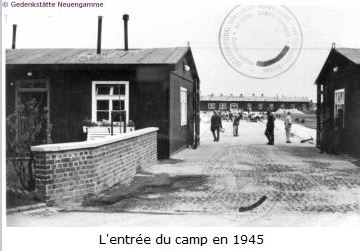After 1945
The camp
In 1948, the camp grounds are handed over to the City of Hamburg civil authority. The civil authority asserted its will to remove the “curse” due to the rerrors of the past, and “to blot out of memory the frightening atrocities of this camp” in order to re-establish its repoutation and honour. The huts and the crematorium were demolished. The authority then had a model detention centre built on the premises, in accordance with modern penitentiary rules.

The victims of the former Neuengmamme Concentration Camp refuses to see their memory deleted in such a way and voice their indignation.
In 1958, they formed the “AMICALE INTERNATIONALE DE NEUENGAMME” (A.I.N). They never stop fighting and had a number of successes.
– In 1953, a modest momument was inaugurated by the French survivors.
– In 1965 un modeste monument commémoratif est inauguré, en 1953, à l’initiative des survivants français ;
– In 1965, a Memorial is erected in memory of the victims of the camp; it bears the inscription: “May your struggle, your suffering, your death not be in vain“
– In 1981, a document building and a first exhibition were opened
– en 1989, the Hamburg Senate decided to transfert the penal facilities to elsewhere in Germany.
Netherveless, the project envolved slowly and met with numerous Financial and adminstrative difficulties. The project had to wait until 1999 for the budget file of a new prison building to be adopted .
In Septembre 2001, the reorganisation project was again called into question by the newly elected Parliament in Hamburg. It neede all the force of will, steadfastness and courage of the Amicale Internationale to come to terms with the Senate and convince them to keep their word.
On juin 30th 2003, the grounds where a second prison had been built in the previous years was handed over by the Ministry of Justice to the Ministry of Culture and the last prisoners were transfered to another prison. The demolition of the prison buildings began in August 2003, to be followed by the reorganisation of the cleared grounds at Neuengamme. .

The trial of the executioners of Neuengamme
On March 18, 1946, the trial of the main SS camp leaders began at the Curio-Haus in Hamburg, before a British military court. There are 14 accused
Max PAULY (Kommandant), Karl TOTZAUER (assistant Kommandant), Anton THUMANN (Lagerführer), Dr. Bruno KITT (Doctor), Willi DREIMANN (rapportführer), Heinrich RUGE ( block Chief), Willi WARNCKE (block Chief), Johan REESE (block Chief), Adolf SPECK (block Chief), Andreas BREMS (block Chief), Wilhelm BAHR (male nurse), Walter KÜMMEL (block Chief), Karl WIEDEMANN (guard commander), Dr. Alfred TRZEBINSKI (First Doctor).
The sentences were pronounced on May 3, 1946: eleven were sentenced to death and hanged on October 8, 1946 in Hameln (*). Totzauer was sentenced to 20 years of forced labor, Wiedemann to 15 years and Kümmel to 10 years.
Marcel Prenant was a witness at this trial on behalf of the Amicale de Neuengamme.
More than 100 procedures then took place until 1948. Twenty SS from Neuengamme or outside Kommandos were sentenced to death and executed. Many others escape condemnation
(*) Hameln is in Lower Saxony, on the right bank of the Weser, 45 km away. southwest of Hanover; she is known for her legend of the flute player.